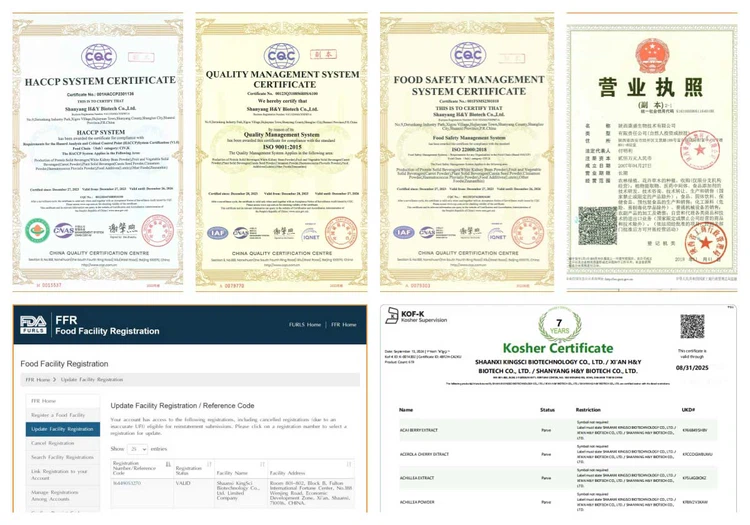What is Bitter Orange Fruit Extract?
Bitter Orange Fruit Extract refers to a natural botanical ingredient made out of the unripe fruit of Citrus aurantium by accredited manufacturers that are widely used in nutraceutical products, pharmaceutical products, functional foods, and even cosmetics. It is characterized by a full array of bioactive compounds, the main of which is p-synphrine, as well as a number of flavonoids (hesperidin, naringin), which adds to its functional value. In this light, the extract enjoys a high reputation for consistency, standardization specifications, and flexibility in bulk formulation, which puts it in a position well suited to manufacturers of dietary supplements, sports nutrition, wellness-based formulas, and functional beverages. It is highly stable, soluble, and compatible with a diversity of processing technologies to smoothly integrate in tablets, capsules, powders, and liquid formulations, with its natural plant-based origin resonating with increasing consumers around the world who prioritize clean-label and truly science-supported ingredients.

COA
| Test Item | Specification | Result |
| Identification | Positive | Positive |
| Active Compound (p-Synephrine) | ≥10% | 10.20% |
| Total Flavonoids (as Hesperidin) | ≥5% | 5.30% |
| Moisture | ≤6.0% | 4.80% |
| Ash Content | ≤4.0% | 3.50% |
| Bulk Density | 0.50–0.65 g/mL | 0.55 g/mL |
| Particle Size | 100% through 60 mesh | Compliant |
| Residual Solvent (Ethanol) | ≤3000 ppm | 2800 ppm |
| Heavy Metals (Pb) | ≤1.5 mg/kg | 0.7 mg/kg |
| Heavy Metals (As) | ≤0.5 mg/kg | 0.2 mg/kg |
| Heavy Metals (Cd) | ≤0.5 mg/kg | 0.15 mg/kg |
| Heavy Metals (Hg) | ≤0.05 mg/kg | ND |
| Microbial Limits: Total Plate Count | ≤500 cfu/g | 180 cfu/g |
| Yeast & Mold | ≤50 cfu/g | <10 cfu/g |
| Staphylococcus aureus | Negative | Negative |
| Salmonella | Negative | Negative |
| E. coli | Negative | Negative |
| Pesticide Residue | Compliant / ND | ND |
Are you interested in our products? Just leave a message on this page or through donna@kingsci.com to get free samples and more professional support!
Source
Bitter Orange Extract is mainly extracted using the unripe fruit of Citrus aurantium, which is harvested during a specific time to help ensure that active compounds achieve maximum levels. Synephrine is the most potent bioactive ingredient in the extract, which is standardized to provide a consistent potency of the extract in use in industry. As well as synephrine, the fruit is naturally rich in flavonoids that include hesperidin and naringin, which reinforce the overall functional profile of the extract. Fruits harvested are washed, selectively separated, washed, and dried in a controlled temperature environment and reduced to a defined size through milling, and extracted through a solvent, usually ethanol, or a mixture of ethanol and water, to extract the active compounds and stabilize them with solubility. This thoughtful sourcing and processing strategy gives manufacturers a consistent, high-quality source of raw material applicable to dietary supplements, functional beverages, sports nutrition ingredients, and other plant-based health products to promote consistent product performance and effective formulation at scale.
History
It is an extract with a lengthy history of use that dates back to older times, as it goes together with modern-day uses. Historically, its source, the immature fruits of Citrus aurantium, have seen use in Asian and Mediterranean societies as a bitter-tasting plant used in herbal preparations and food-based drinks that have been used to improve digestion and overall well-being. The development of phytochemistry and industrial extraction in the 20th century made the bioactive components known, with many currently produced as standardized components, most notably p-synephrine and citrus flavonoids, which are some of the main constituents of some of the health products. It has gained commodity status as a raw material over the last couple of decades or so in the nutraceutical and functional food market, especially in terms of dietary supplements, energy-boosting formulations, and sports nutrition products. The benefits of Citrus Aurantium Extract with verified levels of active compounds, consistent and reliable sourcing, and reliable compliance with international quality requirements have driven adoption of trade by manufacturers in large-scale commercial use around the globe.

Precautions
1. Standardization and Specification Compliance
Manufacturers must be able to ascertain that the purchased extract delivers on the agreed synephrine content and flavonoid profile. Standardization is key in the provision of efficacy of products and the adherence to label claims, especially in dietary supplements, functional beverages, as well as sports nutrition formulations.
2. Storage and Stability
Storage conditions are critical such that the stability of active compounds should be maintained cold (dry) and kept away from direct sunlight. Any unwanted moisture or exposure to heat or light shall be minimized in order to avoid loss of the product and have a consistent quality when running through the production phase.
3. Dosage Form Compatibility
It is necessary to take into consideration the targeted dosage form, which can be capsules, tablets, powders, or beverages. Solubility, flowability, and any compatibility with other ingredients evaluation of the Citrus Aurantium Synephrine should be evaluated to ensure it will perform well in the formulation and produce a uniform product.
4. Regulatory Compliance
The manufacturers should also ensure that the extract is within regional and international regulations, such as limits of heavy metals, microbes, residual solvents, and labeling requirements. Regulatory adherence to documentation like the COAs and GMP certificates,s needs to be checked.
5. Sensory and Formulation Effects
The taste of the extract, which is p-synephrin, is bitter, and this bitter taste can interfere with the flavor in beverages, gummies, or functional foods. The microencapsulation that masking agents or blending can be the solution that manufacturers usually resort to in order to attain the sensory profile that is deemed satisfactory.
6. Quality Control and Testing
Periodic processing of new products is advisable to ensure uniformity of the active ingredient concentration, moisture, microbial safety, or lack of contaminants in the supply. This is to make sure that every production batch is within the internal quality processes and can meet the end product specification.
7. Scale-up and Process Optimization
When inducing the extract to large-scale production, the manufacturers have been advised to evaluate the compatibility of extraction and mixing, uniformity of mixture, and stability during the processing phase. Pilot trials can assist in optimizing the processing conditions and reducing batch-to-batch variation.
Certifications

American warehouse

Exhibitions

Hot Tags: bitter orange fruit extract, China, manufacturers, suppliers, factory, wholesale, price, pricelist, quotation, bulk, in stock, KOSHER, ISO, HACCP







